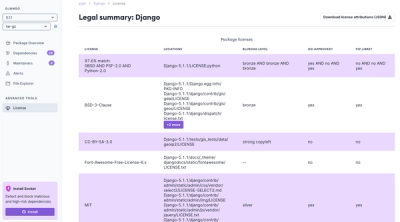
Product
Introducing License Enforcement in Socket
Ensure open-source compliance with Socket’s License Enforcement Beta. Set up your License Policy and secure your software!
django-short-text-field-0.2
Advanced tools
A Django app which adds a ShortTextField model field, whichis like a TextField in the database and like a CharField informs.
A very simple Django app that adds a ShortTextField model field class, which
is treated like a TextField in the database (i.e. the data is stored in the
database with the text rather than the varchar type, and the developer does
not need to specify a max_length), but like a CharField in forms (i.e. it
uses a single-line input). This is ideal for PostgreSQL, which recommends the
'text' type in a wider variety of circumstances than other commonly-used
database backends (see the [PostgreSQL docs]
(https://www.postgresql.org/docs/9.1/static/datatype-character.html)).
Add 'short_text_field' to your INSTALLED_APPS setting like this:
INSTALLED_APPS = [
...
'short_text_field',
]
Add a ShortTextField to a model like this:
from short_text_field.models import ShortTextField
...
class ExampleModel(models.Model):
...
example_field = ShortTextField
A model with a ShortTextField should be registered in the admin site using
short_text_field.admin.ModelAdmin.
admin.site.register(ExampleModel, short_text_field.admin.ModelAdmin)
A subclass of this class will also work:
class ExampleModelAdmin(short_text_field.admin.ModelAdmin):
model = ExampleModel
...
admin.site.register(ExampleModel, ExampleModelAdmin)
If you have a hierarchy of ModelAdmin subclasses, you can still
incorporate short_text_field.admin.ModelAdmin easily as a mixin:
class ExampleModelAdmin2(short_text_field.admin.ModelAdmin, ExampleModelAdmin1):
model = ExampleModel
...
admin.site.register(ExampleModel, ExampleModelAdmin)
You can also use a subclass of short_text_field.admin.AdminSite for the
site, which will make short_text_field.admin.ModelAdmin the default
ModelAdmin subclass to use for registering. In the simplest case, you can
just set the default_site attribute of the AdminConfig class and then
register all of your models in the normal way:
from django.contrib.admin import apps
import short_text_field.admin.AdminSite
...
class ExampleAdminConfig(apps.AdminConfig):
...
default_site = short_text_field.admin.AdminSite
FAQs
A Django app which adds a ShortTextField model field, whichis like a TextField in the database and like a CharField informs.
We found that django-short-text-field-0.2 demonstrated a healthy version release cadence and project activity because the last version was released less than a year ago. It has 1 open source maintainer collaborating on the project.
Did you know?

Socket for GitHub automatically highlights issues in each pull request and monitors the health of all your open source dependencies. Discover the contents of your packages and block harmful activity before you install or update your dependencies.

Product
Ensure open-source compliance with Socket’s License Enforcement Beta. Set up your License Policy and secure your software!

Product
We're launching a new set of license analysis and compliance features for analyzing, managing, and complying with licenses across a range of supported languages and ecosystems.

Product
We're excited to introduce Socket Optimize, a powerful CLI command to secure open source dependencies with tested, optimized package overrides.